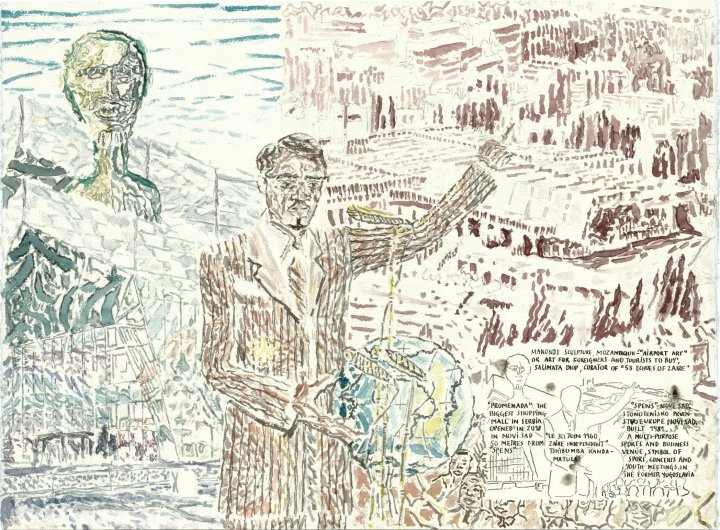
Le 30 Juin 1960 Zaire Independent
Watercolour and ink on paper, 76 x 56cm, 2019
This painting was inspired by a visit to the Serbian city of Novi Sad in 2019. There is a very famous building built in 1981 nicknamed SPENS after the European Table Tennis Championships it hosted and to serve as a local shopping, small business, conference and sports centre (painted on the upper right side). In 2018 a giant shopping mall called Promenada was built directly facing SPENS, containing only major European shopping chains (painted on the left side). This strategic placement of Promenada opposite SPENS has put in question the survival of the latter which continues to function in a much-diminished capacity. This shows the ever-widening division in Serbian society that has opened in the past twenty years. One side of it is that still connected to the memory and values of Yugoslavia thirty years after its break-up, and the other is that embracing the new Serbia as a turbo capitalist and nationalist creation.
This work is also inspired by a painting series on the Independence story of Zaire (now the Democratic Republic of Congo) made by a Congolese painter at the behest of a French sociologist. In its centre I reinterpret his painting of Patrice Lumumba, the former leader of Zaire, giving a very critical speech about the country’s Belgium colonisers. Lumumba was assassinated in a conspiracy by the Belgiums and the CIA in 1961. Yugoslavia played an important part in the destiny of the African and Middle Eastern countries which gained independence after the Second World War through its being one of the pioneers and members of the Non-Aligned Movement. Yugoslavia never had colonies and was a natural choice of ally and partner for the newly independent countries. Several Non-Aligned Movement conferences were hosted by Yugoslavia from the 1950s up to the 1980s. It supported many liberation movements to win independence with material and propaganda means and in the post-colonial period to realise major infrastructure projects. The figure of a Makonde sculpture from Mozambique is painted here as a symbol of the type of art the West expects from such countries and how the painting series of the Congolese artist I reference differs from that. This story entered my own work because I translated several publications relating to this chapter in Yugoslavia's history.